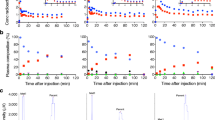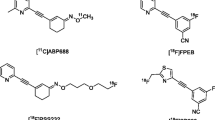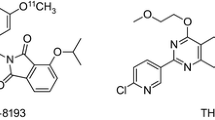Abstract
Purpose
A novel, 18F-labelled metabotropic glutamate receptor subtype 5 (mGlu5) derivative of [11C]ABP688 ([11C]1), [18F]PSS232 ([18F] ]5), was evaluated in vitro and in vivo for its potential as a PET agent and was used in test–retest reliability studies
Methods
The radiosynthesis of [18F]5 was accomplished via a one-step reaction using a mesylate precursor. In vitro stability was determined in PBS and plasma, and with liver microsomal enzymes. Metabolite studies were performed using rat brain extracts, blood and urine. In vitro autoradiography was performed on horizontal slices of rat brain using 1 and 8, antagonists for mGlu5 and mGlu1, respectively. Small-animal PET, biodistribution, and test–retest studies were performed in Wistar rats. In vivo, dose-dependent displacement studies were performed using 6 and blocking studies with 7.
Results
[18F]5 was obtained in decay-corrected maximal radiochemical yield of 37 % with a specific activity of 80 – 400 GBq/μmol. Treatment with rat and human microsomal enzymes in vitro for 60 min resulted in 20 % and 4 % of hydrophilic radiometabolites, respectively. No hydrophilic decomposition products or radiometabolites were found in PBS or plasma. In vitro autoradiography on rat brain slices showed a heterogeneous distribution consistent with the known distribution of mGlu5 with high binding to hippocampal and cortical regions, and negligible radioactivity in the cerebellum. Similar distribution of radioactivity was found in PET images. Under displacement conditions with 6, reduced [18F]5 binding was found in all brain regions except the cerebellum. 7 reduced binding in the striatum by 84 % on average. Test–retest studies were reproducible with a variability ranging from 6.8 % to 8.2 %. An extended single-dose toxicity study in Wistar rats showed no compound-related adverse effects.
Conclusion
The new mGlu5 radiotracer, [18F]5, showed specific and selective in vitro and in vivo properties and is a promising radioligand for PET imaging of mGlu5 in humans.








Similar content being viewed by others
References
DeLorenzo C, Kumar JSD, Mann JJ, Parsey RV. In vivo variation in metabotropic glutamate receptor subtype 5 binding using positron emission tomography and 11C-ABP688. J Cereb Blood Flow Metab. 2011;31(11):2169–80.
Deschwanden A, Karolewicz B, Feyissa AM, Treyer V, Ametamey SM, Johayem A, et al. Reduced metabotropic glutamate receptor 5 density in major depression determined by 11C-ABP688 PET and postmortem study. Am J Psychiatry. 2011;168(7):727–34.
Lüscher C, Huber KM. Group 1 mGluR-dependent synaptic long-term depression: mechanisms and implications for circuitry and disease. Neuron. 2010;65:445–59.
Ritzen A, Mathiesen JM, Thomsen C. Molecular pharmacology and therapeutic prospects of metabotropic glutamate receptor allosteric modulators. Basic Clin Pharmacol. 2005;97(4):202–13.
Spooren W, Ballard T, Gasparini F, Amalric M, Mutel V, Schreiber R. Insight into the function of group I and group II metabotropic glutamate (mGlu) receptors: behavioral characterization and implications for the treatment of CNS disorders. Behav Pharmacol. 2003;14:257–77.
Ohnuma T, Augood SJ, Arai H, McKenna PJ, Emson PC. Expression of the human excitatory amino acid transporter 2 and metabotropic glutamate receptors 3 and 5 in the prefrontal cortex from normal individuals and patients with schizophrenia. Mol Brain Res. 1998;56(1-2):207–17.
Pilc A, Klodzinska A, Branski P, Nowak G, Palucha A, Szewczyk B, et al. Multiple MPEP administrations evoke anxiolytic- and anti-depressant-like effects in rats. Neuropharmacology. 2002;43(2):181–7.
Cosford ND, Tehrani L, Roppe J, Schweiger E, Smith ND, Anderson J, et al. 3-[(2-Methyl-1,3-thiazol-4-yl)ethynyl]-pyridine: a potent and highly selective metabotropic glutamate subtype 5 receptor antagonist with anxiolytic activity. J Med Chem. 2003;46(2):204–6.
Gasparini F, Lingenhohl K, Stoehr N, Flor PJ, Heinrich M, Vranesic I, et al. 2-Methyl-6-(phenylethynyl)-pyridine (MPEP), a potent, selective and systemically active mGluR5 receptor antagonist. Neuropharmacology. 1999;38(10):1493–503.
Chiamulera C, Epping-Jordan MP, Zocchi A, Marcon C, Cottiny CC, Tacconi S, et al. Reinforcing and locomotor stimulant effects of cocaine are absent in mGluR5 null mutant mice. Nat Neurosci. 2001;4(9):873–4.
Todd PK, Mack KJ, Malter JS. The fragile X mental retardation protein is required for type-I metabotropic glutamate receptor-dependent translation of PSD-95. Proc Natl Acad Sci U S A. 2003;100(24):14374–8.
Bruno V, Ksiazek I, Battaglia G, Lukic S, Leonhardt T, Sauer D, et al. Selective blockade of metabotropic glutamate receptor subtype 5 is neuroprotective. Neuropharmacology. 2000;39(12):2223–30.
Wang Q, Walsh DM, Rowan MJ, Selkoe DJ, Anwyl R. Block of long-term potentiation by naturally secreted and synthetic amyloid beta-peptide in hippocampal slices is mediated via activation of the kinases c-Jun N-terminal kinase, cyclin-dependent kinase 5 and p38 mitogen-activated protein kinase as well as metabotropic glutamate receptor type 5. J Neurosci. 2004;24(13):3370–8.
Ossowska K, Konieczny J, Wardas J, Pietraszek M, Kuter K, Wolfarth S, et al. An influence of ligands of metabotropic glutamate receptor subtypes on Parkinsonian-like symptoms and the striatopallidal pathway in rats. Amino Acids. 2007;32(2):179–88.
Rouse ST, Marino MJ, Bradley SR, Awad H, Wittmann M, Conn PJ. Distribution and roles of metabotropic glutamate receptors in the basal ganglia motor circuit: implications for treatment of Parkinson's disease and related disorders. Pharmacol Ther. 2000;88(3):427–35.
Zonta M, Angulo MC, Gobbo S, Rosengarten B, Hossmann KA, Pozzan T, et al. Neuron-to-astrocyte signaling is central to the dynamic control of brain microcirculation. Nat Neurosci. 2003;6(1):43–50.
Aronica E, Catania MV, Geurts J, Yankaya B, Troost D. Immunohistochemical localization of group I and II metabotropic glutamate receptors in control and amyotropic lateral sclerosis human spinal cord: upregulation in reactive astrocytes. Neuroscience. 2001;105(2):509–20.
Aronica E, Gorter JA, Jansen GH, van Veelen CW, van Rijen PC, Ramkema M, et al. Expression and cell distribution of group I and II metabotropic glutamate receptor subtypes in Taylor-type focal cortical dysplasia. Epilepsia. 2003;44(6):785–95.
Ametamey SM, Kessler LJ, Honer M, Wyss MT, Buck A, Hintermann S, et al. Radiosynthesis and preclinical evaluation of 11C-ABP688 as a probe for imaging the metabotropic glutamate receptor subtype 5. J Nucl Med. 2006;47(4):698–705.
Ametamey SM, Treyer V, Streffer J, Wyss MT, Schmidt M, Blagoev M, et al. Human PET studies of metabotropic glutamate receptor subtype 5 with 11C-ABP688. J Nucl Med. 2007;48(2):247–52.
Burger C, Deschwanden A, Ametamey S, Johayem A, Mancosu B, Wyss M, et al. Evaluation of bolus/infusion protocol for 11C-ABP688, a PET tracer for mGluR5. Nucl Med Bio. 2010;37(7):845–51.
Treyer V, Streffer J, Wyss MT, Bettio A, Ametamey SM, Fischer U, et al. Evaluation of the metabotropic glutamate receptor subtype 5 using PET and 11C-ABP688: assessment of methods. J Nucl Med. 2007;48(7):1207–15.
Wyss MT, Ametamey SM, Valerie T, Andrea B, Blagoev M, Kessler LJ, et al. Quantitative evaluation of 11C-ABP688 as PET ligand for the measurement of the metabotropic glutamate receptor subtype 5 using autoradiographic studies and beta-scintillator. Neuroimage. 2007;35(3):1086–92.
Shetty HU, Zoghbi SS, Simeon FG, Liow JS, Brown AK, Kannan P, et al. Radiodefluorination of 3-fluoro-5-(2-(2-[18F](fluoromethyl)-thiazol-4-yl)ethynyl)benzonitrile ([18F]SP203), a radioligand for imaging brain metabotropic glutamate subtype-5 receptors with positron emission tomography, occurs by glutathionylation in rat brain. J Pharmacol Exp Ther. 2008;327(3):727–35.
Simeon FG, Brown AK, Zoghbi SS, Patterson VM, Innis RB, Pike VW. Synthesis and simple 18F-labeling of 3-fluoro-5-(2-(2-(fluoromethyl)thiazol-4-yl)ethynyl)benzonitrile as a high affinity radioligand for imaging monkey brain metabotropic glutamate subtype-5 receptors with positron emission tomography. J Med Chem. 2007;50(14):3256–66.
Barret O, Tamagnan G, Batis J, Jennings D, Zubal G, Russell D, et al. Quantitation of glutamate mGluR5 receptor with 18F-FPEB PET in humans. J Nucl Med. 2010;51 Suppl 2:215.
Wong DF, Waterhouse R, Kuwabara H, Kim J, Brasic JR, Chamroonrat W, et al. 18F-FPEB, a PET radiopharmaceutical for quantifying metabotropic glutamate 5 receptors: a first-in-human study of radiochemical safety, biokinetics, and radiation dosimetry. J Nucl Med. 2013;54(3):388–96.
Baumann CA, Mu L, Wertli N, Kramer SD, Honer M, Schubiger PA, et al. Syntheses and pharmacological charazterization of novel thiazole derivatives as potential mGluR5 PET ligands. Bioorg Med Chem. 2010;18(16):6044–54.
Honer M, Stoffel A, Kessler LJ, Schubiger PA, Ametamey SM. Radiolabeling and in vitro and in vivo evaluation of [18F]-FE-DABP688 as a PET radioligand for the metabotropic glutamate receptor subtype 5. Nucl Med Biol. 2007;34(8):973–80.
Lucatelli C, Honer M, Salazar JF, Ross TL, Schubiger PA, Ametamey SM. Synthesis, radiolabeling, in vitro and in vivo evaluation of [18F]-FPECMO as a positron emission tomography radioligand for imaging the metabotropic glutamate receptor subtype 5. Nucl Med Biol. 2009;36(6):613–22.
Sephton SM, Dennler P, Leutwiler D, Mu L, Wanger-Baumann CA, Schibli R, et al. Synthesis, radiolabelling and in vitro and in vivo evaluation of a novel fluorinated ABP688 derivative or the PET imaging of metabotropic glutamate receptor subtype 5. Am J Nucl Med Mol Imaging. 2012;2(1):14–28.
Sephton SM, Mu L, Schweizer WB, Schibli R, Krämer SD, Ametamey SM. Synthesis and evaluation of novel α-fluorinated (E)-3-((6-methylpyridin-2-yl)ethynyl)cyclohex-2-enone-O-methyl oxime (ABP688) derivatives as metabotropic glutamate receptor subtype 5 PET radiotracers. J Med Chem. 2012;55(16):7154–62.
Wanger-Baumann CA, Mu L, Honer M, Belli S, Alf MF, Schubiger PA, et al. In vitro and in vivo evaluation of [18F]-FDEGPECO as a PET tracer for imaging the metabotropic glutamate receptor subtype 5 (mGluR5). Neuroimage. 2011;56(3):984–91.
Sephton SM, Mu L, Dragic M, Krämer SD, Schibli R, Ametamey SM. Synthesis and in vitro evaluation of E- and Z-geometrical isomers of PSS232 as potential metabotropic glutamate receptor subtype 5 (mGlu5) binders. Synthesis. 2013;45:1877–85.
Lavreysen H, Wouters R, Bischoff F, Nobrega Pereira S, Langlois X, Blokland S, et al. JNJ16259685, a highly potent, selective and systemically active mGlu1 antagonist. Neuropharmacology. 2004;47(7):961–72.
Elmenhorst D, Aliaga A, Bauer A, Rosa-Neto P. Test-retest stability of cerebral mGluR5 quantification using [11C]ABP688 and positron emission tomography in rats. Synapse. 2012;66(6):552–60.
Yu M, Tueckmantel W, Wang X, Zhu A, Kozikowski AP, Brownell AL. Methoxyphenylethynyl, methoxypyridylethynyl and phenylethynyl derivatives of pyridine: synthesis, radiolabeling and evaluation of new PET ligands for metabotropic glutamate subtype 5 receptors. Nucl Med Biol. 2005;32(6):631–40.
Anderson JJ, Bradbury MJ, Giracello DR, Chapman DF, Holtz G, Roppe J, et al. In vivo receptor occupancy of mGlu5 receptor antagonists using the novel radioligand [3H]3-methoxy-5-(pyridin-2-ylethynyl)pyridine). Eur J Pharmacol. 2003;473(1):35–40.
Kramer SD, Testa B. The biochemistry of drug metabolism – an introduction: Part 6. Inter-individual factors affecting drug metabolism. Chem Biodivers. 2008;5:2465–578.
Wang JQ, Tueckmantel W, Zhu A, Pellegrino D, Brownell AL. Synthesis and preliminary biological evaluation of 3-[(18)F]fluoro-5-(2-pyridinylethynyl)benzonitrile as a PET radiotracer for imaging metabotropic glutamate receptor subtype 5. Synapse. 2007;61(12):951–61.
Acknowledgments
The authors thank Aretussa Apladas and Martin Hungerbühler for technical support in the PET laboratory, Daniel Bieri, Dr. Lukas O. Dialer and Dr. Cindy R. Fischer for assistance with the biodistribution experiments, Stjepko Cermak (Institute Rudjer Boskovic, Zagreb, Croatia) for assistance with the test–retest study, and Susanne Geistlich for the toxicity studies. Dr. Thomas Nauser and Martina Dragic are acknowledged for support in the radiochemistry lab as well as Dominique Leutwiler with the microsome stability assays.
Conflicts of interest
None.
Author information
Authors and Affiliations
Corresponding author
Additional information
Selena Milicevic Sephton and Adrienne Müller Herde contributed equally to this work.
Rights and permissions
About this article
Cite this article
Sephton, S.M., Herde, A.M., Mu, L. et al. Preclinical evaluation and test–retest studies of [18F]PSS232, a novel radioligand for targeting metabotropic glutamate receptor 5 (mGlu5). Eur J Nucl Med Mol Imaging 42, 128–137 (2015). https://doi.org/10.1007/s00259-014-2883-7
Received:
Accepted:
Published:
Issue Date:
DOI: https://doi.org/10.1007/s00259-014-2883-7




